Performance Evaluation of Electrochromic Windows in Cold-Region University Classrooms: A Multi-Scale Simulation Study
Abstract
1. Introduction
1.1. Motivation
1.2. Scientific Originality
1.3. Targets of This Research
2. Methodology
2.1. Study Building Specification
2.2. Climatic Context of Xi’an
2.3. Performance Indicators
2.4. Control Strategies and Parameter Settings
- Illuminance-based control strategy
- Incident solar radiation-based control strategy
- Temperature-based control strategy
2.5. Simulation Tools and Boundary Conditions
3. Result and Analysis
3.1. Baseline Case Analysis
3.1.1. Visual Comfort in Three Classroom Types
3.1.2. Thermal Comfort in Three Classroom Types
3.1.3. Annual Indoor Temperature Distribution in Three Classroom Types
3.1.4. Cooling Energy Consumption in Three Classroom Types
3.1.5. Heating Energy Consumption in Three Classroom Types
3.2. Performance Analysis with Electrochromic Windows
3.2.1. Type I Classroom
3.2.2. Type II Classroom
3.2.3. Type III Classroom
4. Discussion
5. Conclusions
- Improved indoor comfort: With ECWs, annual mean indoor temperatures increased in all classrooms, thermal comfort time ratios improved by +0.6–4.5%, and visual comfort time ratios improved by +1.1–6.3%. The small classroom achieved the most significant improvements, highlighting that ECWs are particularly effective in compact high-density spaces.
- Energy savings dependent on scale and strategy: ECWs effectively reduced both heating and cooling demands, with heating energy reductions of −3.2 to −11.6 kWh/m2 and cooling reductions of −4.0% to −14.3%. The greatest savings occurred in the small classroom, while improvements in the large classroom were comparatively limited, suggesting that ECWs’ effectiveness is scale-sensitive.
- Strategy-specific advantages: Temperature-based control was most effective in improving thermal comfort and reducing heating demands; illuminance-based control excelled in enhancing visual comfort; solar-radiation-based control provided the greatest cooling load reduction. This demonstrates that no single control approach is universally optimal, and strategy selection should be tailored to design priorities.
- Scale effects: The benefits of ECWs diminished with an increase in classroom size, implying that large spaces may require integration with supplementary systems such as artificial lighting or shading devices to achieve optimal performance.
Author Contributions
Funding
Institutional Review Board Statement
Informed Consent Statement
Data Availability Statement
Acknowledgments
Conflicts of Interest
References
- Ghulam, A.; Khalid, Z.; Shukui, T.; Tan, S.-k.; Faiza, S. Does energy consumption contribute to climate change? Evidence from major regions of the world. Renew. Sustain. Energy Rev. 2014. [Google Scholar] [CrossRef]
- Ma, M.; Cai, W.; Cai, W. Carbon abatement in China’s commercial building sector: A bottom-up measurement model based on Kaya–LMDI methods. Energy 2018, 165, 350–368. [Google Scholar] [CrossRef]
- Adriana, C.; Federica, R.; Jacopo, D.O.; Virgilio, C.; Marco, F.; Ferdinando, S. Multi-objective approach to the optimization of shape and envelope in building energy design. Appl. Energy 2020. [Google Scholar] [CrossRef]
- Fatima, H.; Farouk, F.; Pascal Henry, B. Passive design optimization of low energy buildings in different climates. Energy 2018, 165, 591–613. [Google Scholar] [CrossRef]
- Xu, Y.; Zhang, G.; Yang, C.; Wang, G.; Jiang, Y.; Zhang, K. A two-stage multi-objective optimization method for envelope and energy generation systems of primary and secondary school teaching buildings in China. Build. Environ. 2021, 204, 108142. [Google Scholar] [CrossRef]
- Meng, X. Influence of air-conditioning intermittent operation on the cooling load from opaque envelopes in residences. Case Stud. Therm. Eng. 2024, 58, 104393. [Google Scholar] [CrossRef]
- Ascione, F.; Bianco, N.; Mauro, G.M.; Napolitano, D.F. Building envelope design: Multi-objective optimization to minimize energy consumption, global cost and thermal discomfort. Application to different Italian climatic zones. Energy 2019, 174, 359–374. [Google Scholar] [CrossRef]
- Chi, F.; Xu, Y. Building performance optimization for university dormitory through integration of digital gene map into multi-objective genetic algorithm. Appl. Energy 2022, 307, 118211. [Google Scholar] [CrossRef]
- Baraa, J.A.-K.; Shouib Nouh, M.B. Improving visual comfort and energy efficiency in existing classrooms using passive daylighting techniques. Energy Procedia 2017, 136, 102–108. [Google Scholar] [CrossRef]
- Aburas, M.; Soebarto, V.; Williamson, T.; Liang, R.; Ebendorff-Heidepriem, H.; Wu, Y. Thermochromic smart window technologies for building application: A review. Appl. Energy 2019, 255, 113522. [Google Scholar] [CrossRef]
- Acosta-Acosta, D.F.; El-Rayes, K. Optimal design of classroom spaces in naturally ventilated buildings to maximize occupant satisfaction with human bioeffluents/body odor levels. Build. Environ. 2020, 169, 106543. [Google Scholar] [CrossRef]
- Bakmohammadi, P.; Noorzai, E. Optimization of the design of the primary school classrooms in terms of energy and daylight performance considering occupants’ thermal and visual comfort. Energy Rep. 2020, 6, 1590–1607. [Google Scholar] [CrossRef]
- Doulos, L.T.; Kontadakis, A.; Madias, E.N.; Sinou, M.; Tsangrassoulis, A. Minimizing energy consumption for artificial lighting in a typical classroom of a Hellenic public school aiming for near Zero Energy Building using LED DC luminaires and daylight harvesting systems. Energy Build. 2019, 194, 201–217. [Google Scholar] [CrossRef]
- Dussault, J.M.; Gosselin, L. Office buildings with electrochromic windows: A sensitivity analysis of design parameters on energy performance, and thermal and visual comfort. Energy Build. 2017, 153, 50–62. [Google Scholar] [CrossRef]
- Giouri, E.D.; Tenpierik, M.; Turrin, M. Zero energy potential of a high-rise office building in a Mediterranean climate: Using multi-objective optimization to understand the impact of design decisions towards zero-energy high-rise buildings. Energy Build. 2017, 209, 109666. [Google Scholar] [CrossRef]
- Zhao, J.; Du, Y. Multi-objective optimization design for windows and shading configuration considering energy consumption and thermal comfort: A case study for office building in different climatic regions of China. Sol. Energy 2020, 206, 997–1017. [Google Scholar] [CrossRef]
- Si, P.; Feng, Y.; Lv, Y.; Rong, X.; Pan, Y.; Liu, X.; Yan, J. An optimization method applied to active solar energy systems for buildings in cold plateau areas—The case of Lhasa. Appl. Energy 2017, 194, 487–498. [Google Scholar] [CrossRef]
- Teixeira, H.; Moret Rodrigues, A.; Aelenei, D.; Gomes, M.G. Simulation-based evaluation of the impact of an electrochromic glazing on the energy use and indoor comfort of an office room. Energies 2024, 17, 2110. [Google Scholar] [CrossRef]
- Xu, Y.; Yan, C.; Yan, S.; Liu, H.; Pan, Y.; Zhu, F.; Jiang, Y. A multi-objective optimization method based on an adaptive meta-model for classroom design with smart electrochromic windows. Energy 2021, 243, 122777. [Google Scholar] [CrossRef]
- Lashgari, S.; Jahangir, M.H. A comparative analysis of thermal comfort, energy consumption, pollutant emissions, and visual comfort in a school building utilizing electrochromic and thermochromic windows. Energy Strategy Rev. 2025, 60, 101772. [Google Scholar] [CrossRef]
- Fang, Y.; Eames, P.C.; Norton, B.; Hyde, T.; Huang, Y.; Hewitt, N. The thermal performance of an electrochromic vacuum glazing with selected low-emittance coatings. Thin Solid Film. 2008, 516, 1074–1081. [Google Scholar] [CrossRef]
- Lu, W. Dynamic shading and glazing technologies: Improve energy, visual, and thermal performance. Energy Built Environ. 2024, 5, 211–229. [Google Scholar] [CrossRef]
- Pittaluga, M. The electrochromic wall. Energy Build. 2013, 66, 49–56. [Google Scholar] [CrossRef]
- Wu, S.; Sun, H.; Duan, M.; Mao, H.; Wu, Y.; Zhao, H.; Lin, B. Applications of thermochromic and electrochromic smart windows: Materials to buildings. Cell Rep. Phys. Sci. 2023, 4, 101370. [Google Scholar] [CrossRef]
- Wu, X.; Zhang, W.; Xie, L.; Zhao, O.; Li, Z.; Li, J.; Zhong, J. Study on the impact of partition photovoltaic electrochromic windows on building lighting environment and energy saving. Energy Build. 2023, 280, 112722. [Google Scholar] [CrossRef]
- Isaia, F.; Fiorentini, M.; Serra, V.; Capozzoli, A. Enhancing energy efficiency and comfort in buildings through model predictive control for dynamic façades with electrochromic glazing. J. Build. Eng. 2021, 43, 102535. [Google Scholar] [CrossRef]
- Sun, Y.; Hao, Y.; Wang, D.; Wang, W.; Deng, S.; Qi, H.; Xue, P. A predictive control strategy for electrochromic glazing to balance the visual and thermal environmental requirements: Approach and energy-saving potential assessment. Renew. Energy 2022, 194, 334–348. [Google Scholar] [CrossRef]
- Li, W.; Shah, K.W.; Li, Y. Effects of electrochromic glass window on energy efficiency, thermal and visual performances under tropical climate. Energy Sustain. Dev. 2023, 76, 101300. [Google Scholar] [CrossRef]
- Wong, I.L. A review of daylighting design and implementation in buildings. Renew. Sustain. Energy Rev. 2017, 74, 959–968. [Google Scholar] [CrossRef]
- Marszal, A.J.; Heiselberg, P.; Bourrelle, J.S.; Musall, E.; Voss, K.; Sartori, I.; Napolitano, A. Zero Energy Building—A review of definitions and calculation methodologies. Energy Build. 2011, 43, 971–979. [Google Scholar] [CrossRef]
- Hamdy, M.; Nguyen, A.-T.; Hensen, J.L.M. A performance comparison of multi-objective optimization algorithms for solving nearly-zero-energy-building design problems. Energy Build. 2016, 121, 57–71. [Google Scholar] [CrossRef]
- Fernandes, L.L.; Lee, E.S.; Ward, G. Lighting energy savings potential of split-pane electrochromic windows controlled for daylighting with visual comfort. Energy Build. 2013, 61, 8–20. [Google Scholar] [CrossRef]
- Jain, S.; Karmann, C.; Wienold, J. Behind electrochromic glazing: Assessing user’s perception of glare from the sun in a controlled environment. Energy Build. 2022, 256, 111738. [Google Scholar] [CrossRef]
- Lee, J.H.; Jeong, J.; Chae, Y.T. Optimal control parameter for electrochromic glazing operation in commercial buildings under different climatic conditions. Appl. Energy 2020, 260, 114338. [Google Scholar] [CrossRef]
- Iastiaque Martins, G.; Secco, D.; Kazue Tokura, L.; Aparecido Bariccatti, R.; Dresch Dolci, B.; Ferreira Santos, R. Potential of tilapia oil and waste in biodiesel production. Renew. Sustain. Energy Rev. 2015, 42, 234–239. [Google Scholar] [CrossRef]
- Sandra Carolina, C.M.; Malcolm, C.; Andreas, W. Avoiding overheating in existing school buildings through optimized passive measures. Build. Res. Inf. 2019, 48, 349–363. [Google Scholar] [CrossRef]
- Scofield, J.H. Comment on the paper entitled, “A review of operating performance in green buildings: Energy use, indoor environmental quality and occupant satisfaction” by Geng et al. Energy Build. 2019, 194, 369–371. [Google Scholar] [CrossRef]
- Liu, Q.B.; Ren, J. Energy-Saving Design Methods for Existing University Buildings in Cold Climate Regions. In Sustainable Buildings and Structures; CRC Press: Boca Raton, FL, USA, 2015; pp. 123–138. [Google Scholar]
- Wang, L.; Wang, Y.; Fei, F.; Yao, W.; Sun, L. Study on winter thermal environment characteristics and thermal comfort of university classrooms in cold regions of China. Energy Build. 2023, 291, 113126. [Google Scholar] [CrossRef]
- Mo, W.; Yao, X.; Liu, Z.-A.; Chen, S.; Li, Q.; Jiang, J.; Zhang, G.; Dewancker, B.J. Towards sustainable living in high radiation cold climates: A two-phase genetic algorithm approach for residential building optimization. Build. Environ. 2024, 266, 112133. [Google Scholar] [CrossRef]
- Kera, L.; Jeff, N.; Christoph, R.; Christoph, F.R. Animated building performance simulation (ABPS)—Linking Rhinoceros/Grasshopper with Radiance/Daysim. In Proceedings of the Fourth National Conference of IBPSA-USA, New York, NY, USA, 11–13 August 2010. [Google Scholar]
- Song, Y.; Liu, J.; Zhang, W. Design Parameters Affecting Energy Consumption of University Educational Buildings in Hot Summer and Cold Winter Area of China. Buildings 2024, 14, 1697. [Google Scholar] [CrossRef]
- ANSI/ASHRAE Standard 55-2010; Thermal Environmental Conditions for Human Occupancy. American Society of Heating RaA-CE: Peachtree Corners, GA, USA, 2010.
- Development MoHaU-R. Standard for Lighting Design of Buildings. 2013. Available online: http://lancarver.com/UpFiles/pdf/2014-08-11/081112492125.pdf (accessed on 1 October 2025).
- Nocente, A.; Alessandro, N.; Grynning, S.; Steinar, G.; Gullbrekken, L.; Lars, G. Electrochromic Glass system in Norwegian Climate: Control strategies and Impact on the indoor thermal conditions. J. Phys. Conf. Ser. 2021, 2069, 012127. [Google Scholar] [CrossRef]
- Li, Z.; Wu, Z. A study on the impact of electrochromic glazing on indoor environment. J. Build. Eng. 2024, 86, 108684. [Google Scholar] [CrossRef]
- DeForest, N.; Shehabi, A.; O’Donnell, J.; Garcia, G.; Greenblatt, J.; Lee, E.S.; Selkowitz, S.; Milliron, D.J. United States energy and CO2 savings potential from deployment of near-infrared electrochromic window glazings. Build. Environ. 2015, 89, 107–117. [Google Scholar] [CrossRef]
- Sun, Y.; Li, Y.; Xu, W.; Wang, W.; Wei, W.; Zhang, C. A glare predictive control strategy for split-pane electrochromic windows: Visual comfort and energy-saving assessment. Renew. Energy 2023, 218, 119259. [Google Scholar] [CrossRef]
- Oh, M.; Jang, M.; Moon, J.; Roh, S. Evaluation of Building Energy and Daylight Performance of Electrochromic Glazing for Optimal Control in Three Different Climate Zones. Sustainability 2019, 11, 287. [Google Scholar] [CrossRef]
- Detsi, M.; Manolitsis, A.; Atsonios, I.; Mandilaras, I.; Founti, M. Energy Savings in an Office Building with High WWR Using Glazing Systems Combining Thermochromic and Electrochromic Layers. Energies 2020, 13, 3020. [Google Scholar] [CrossRef]
- Mi, W.; Pu, J.; Shen, C.; Chen, G.; Soteris, K.A. Vacuum-structured electrochromic glazing windows with ultra-low U-Values for building energy savings in all climatic zones. Energy 2025, 336, 138496. [Google Scholar] [CrossRef]
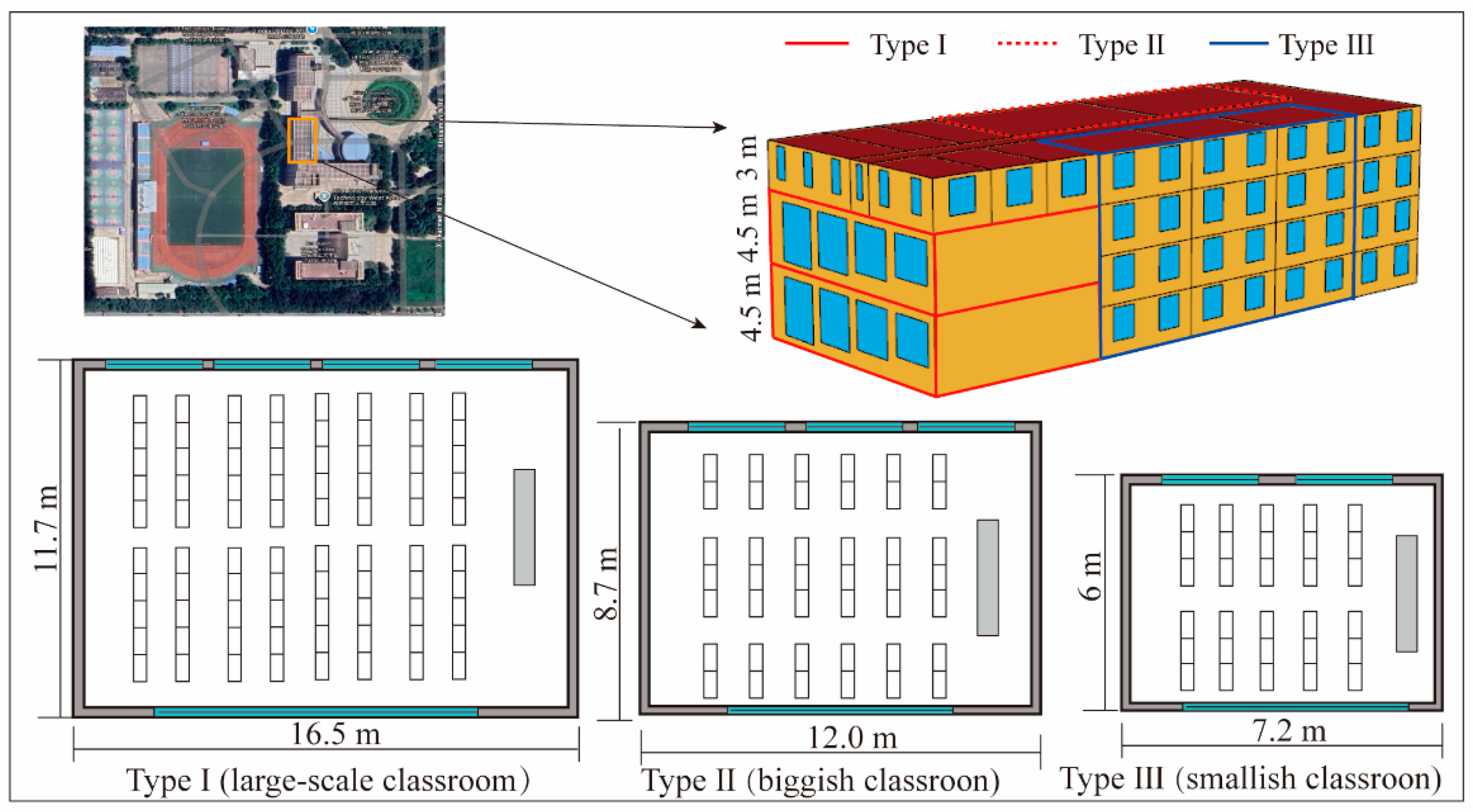
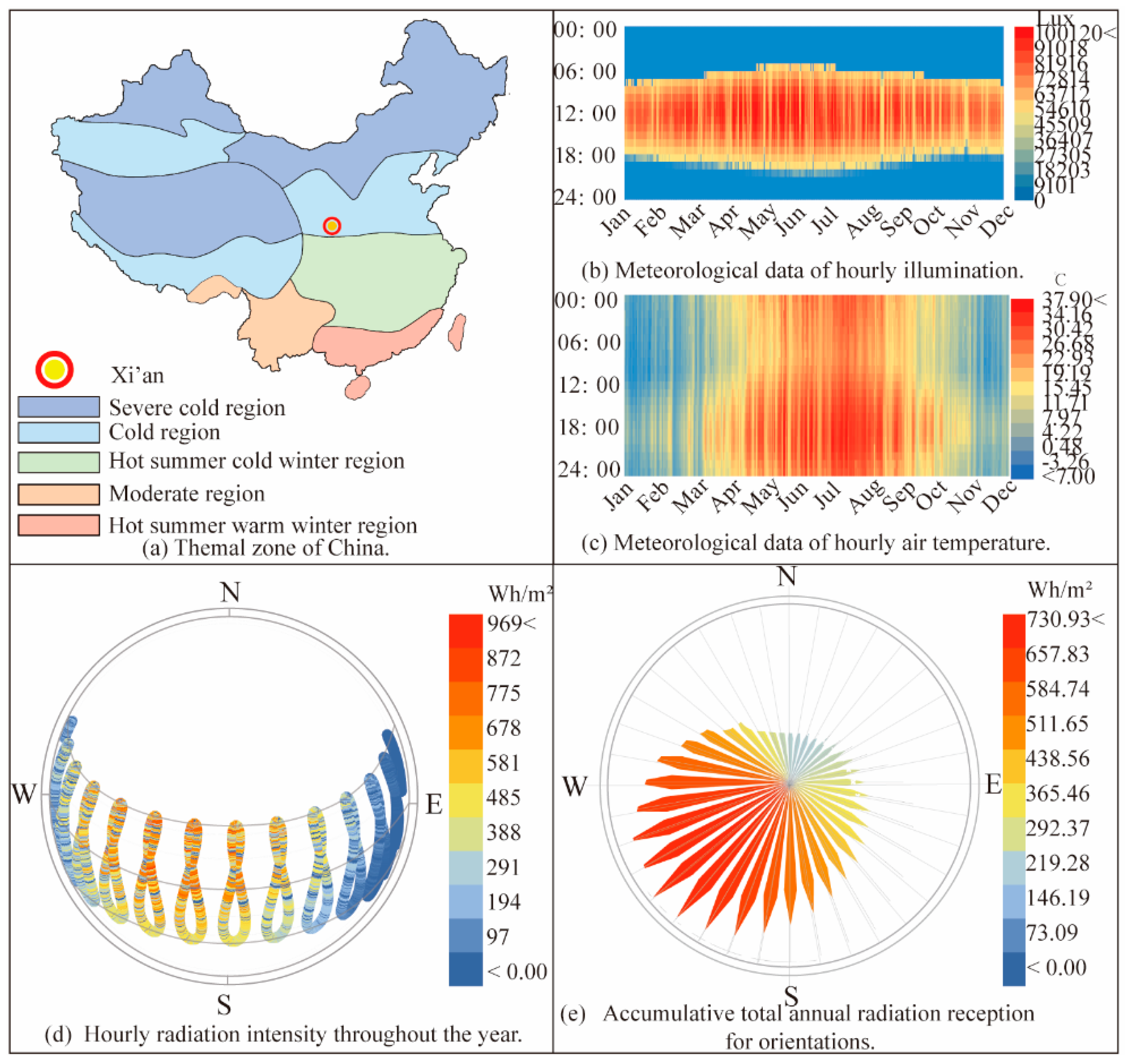
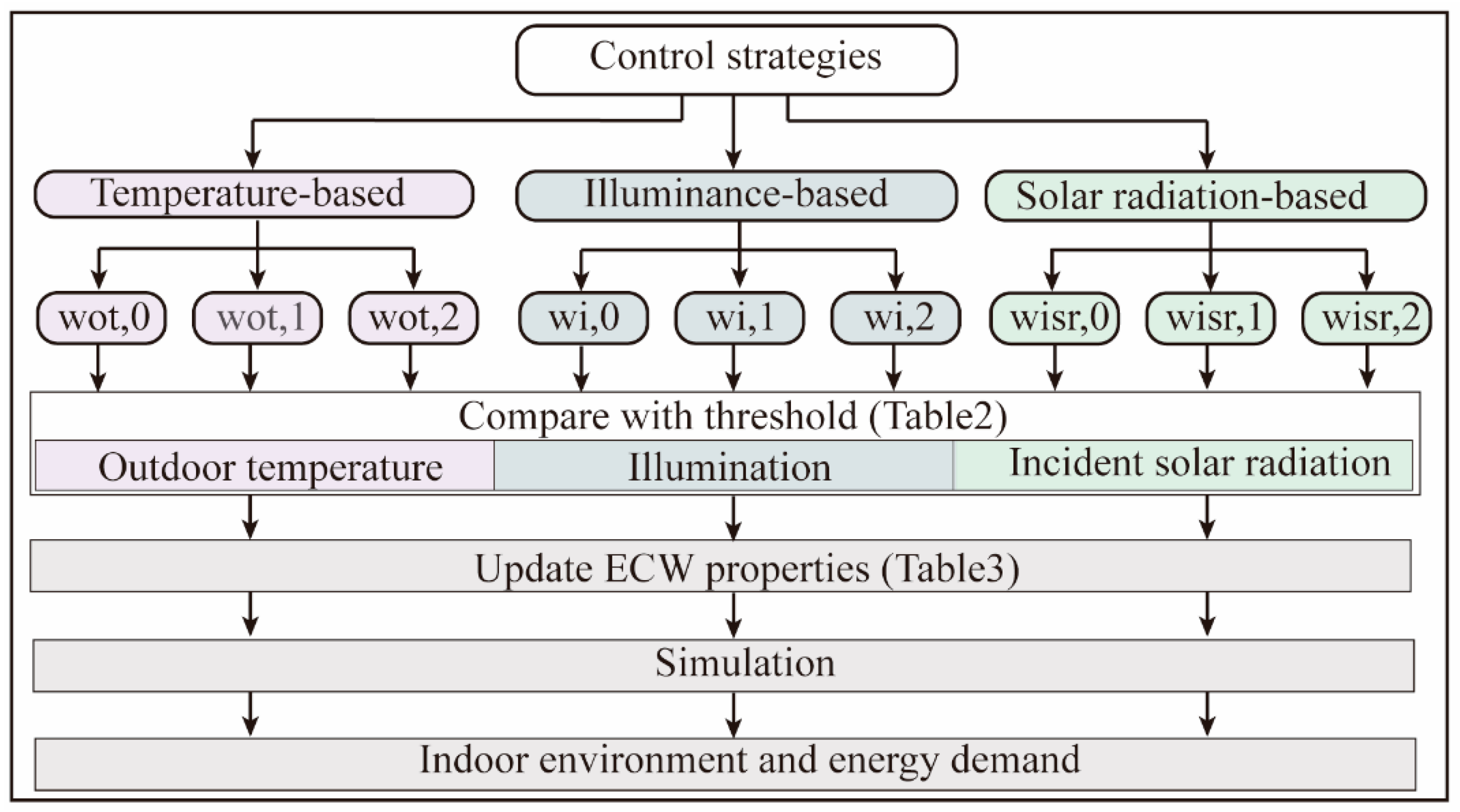

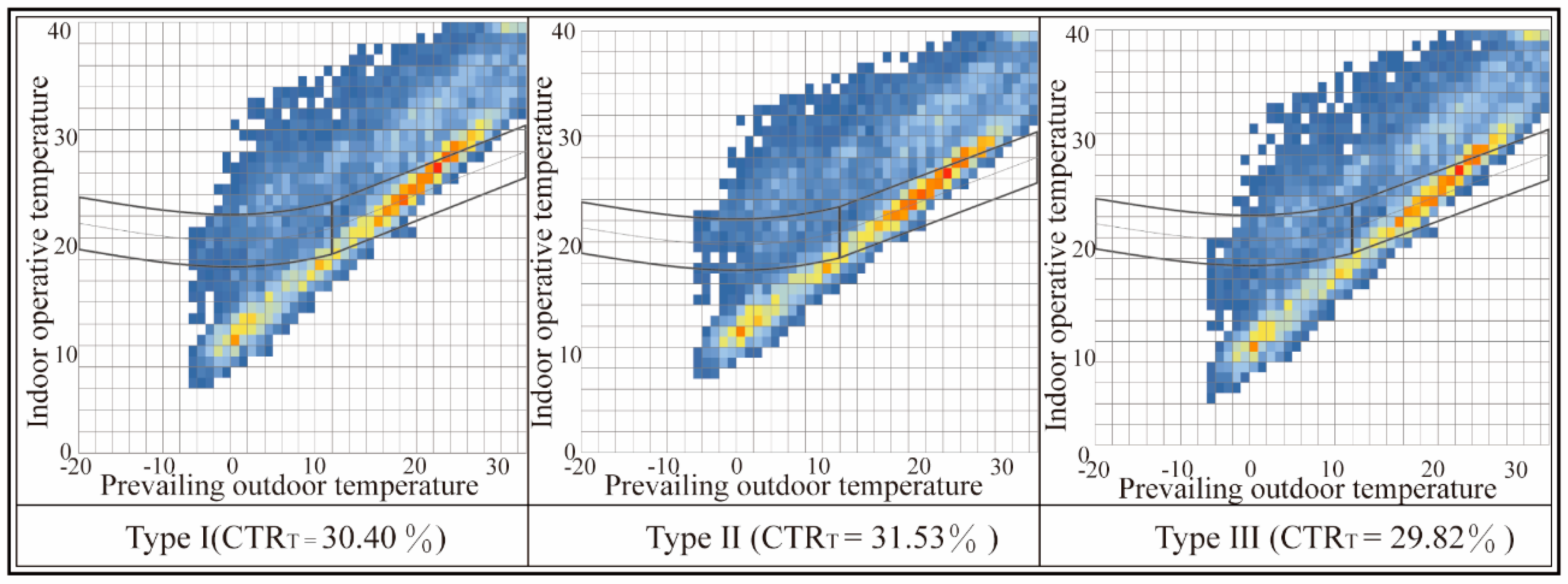
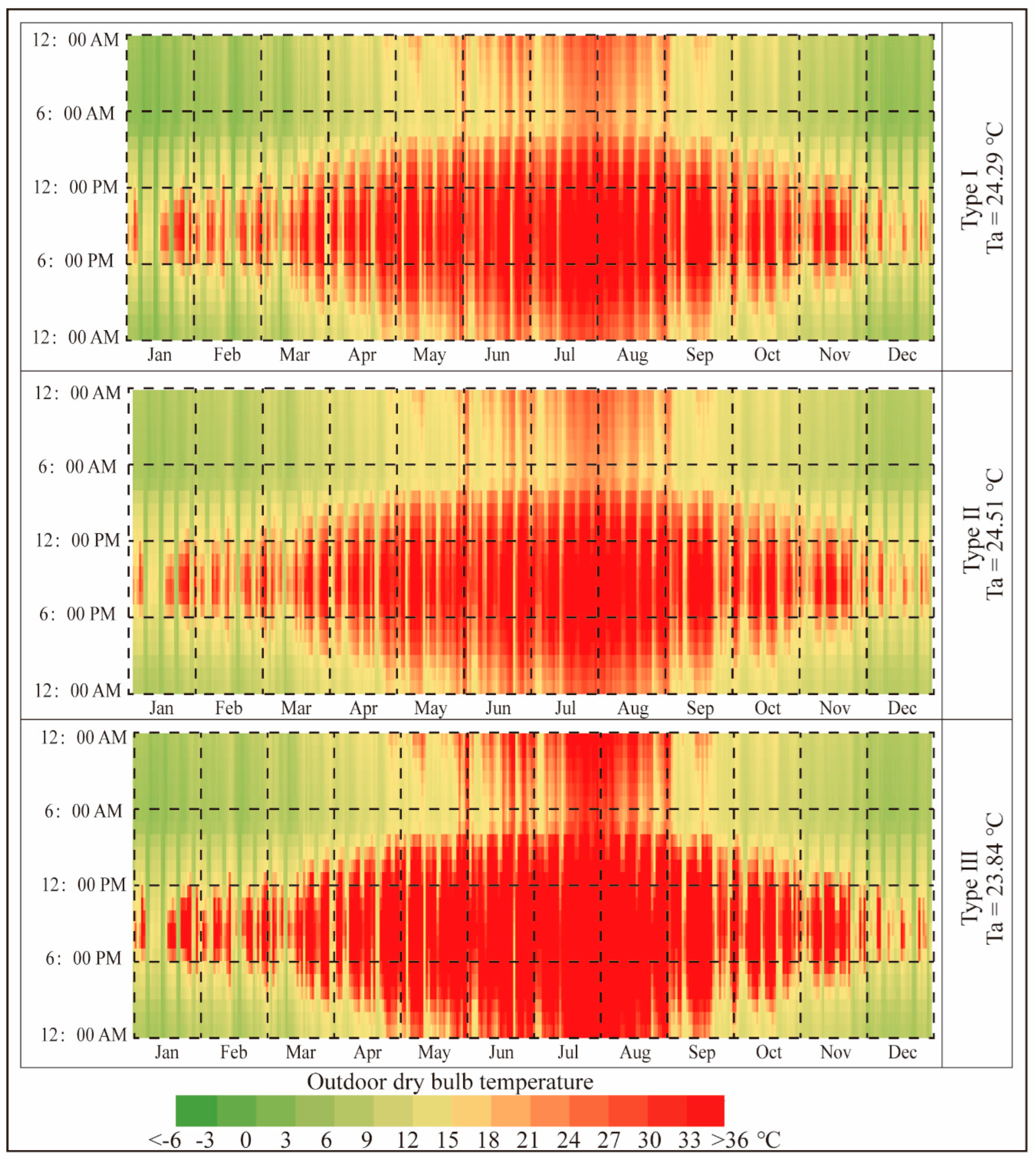
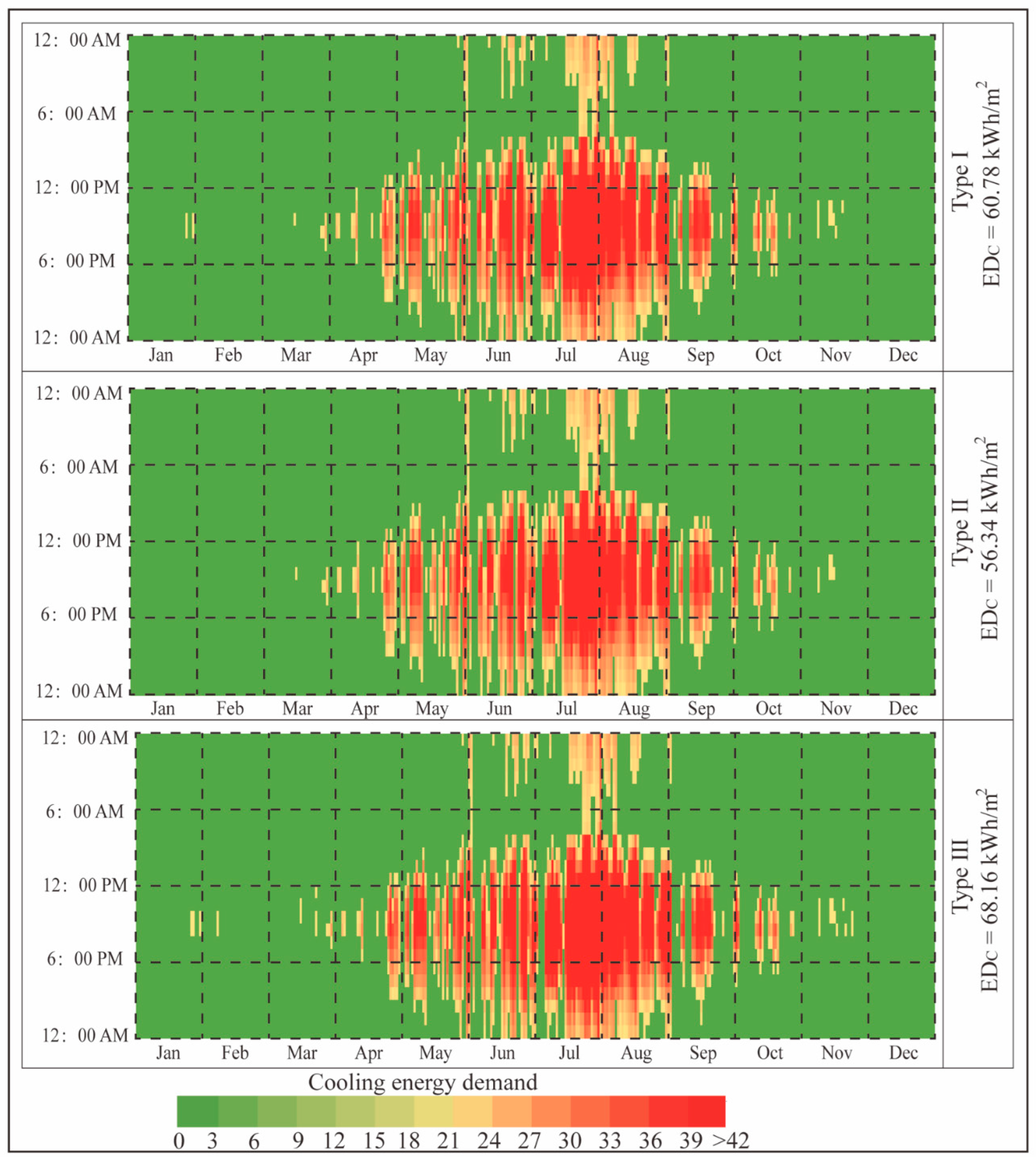
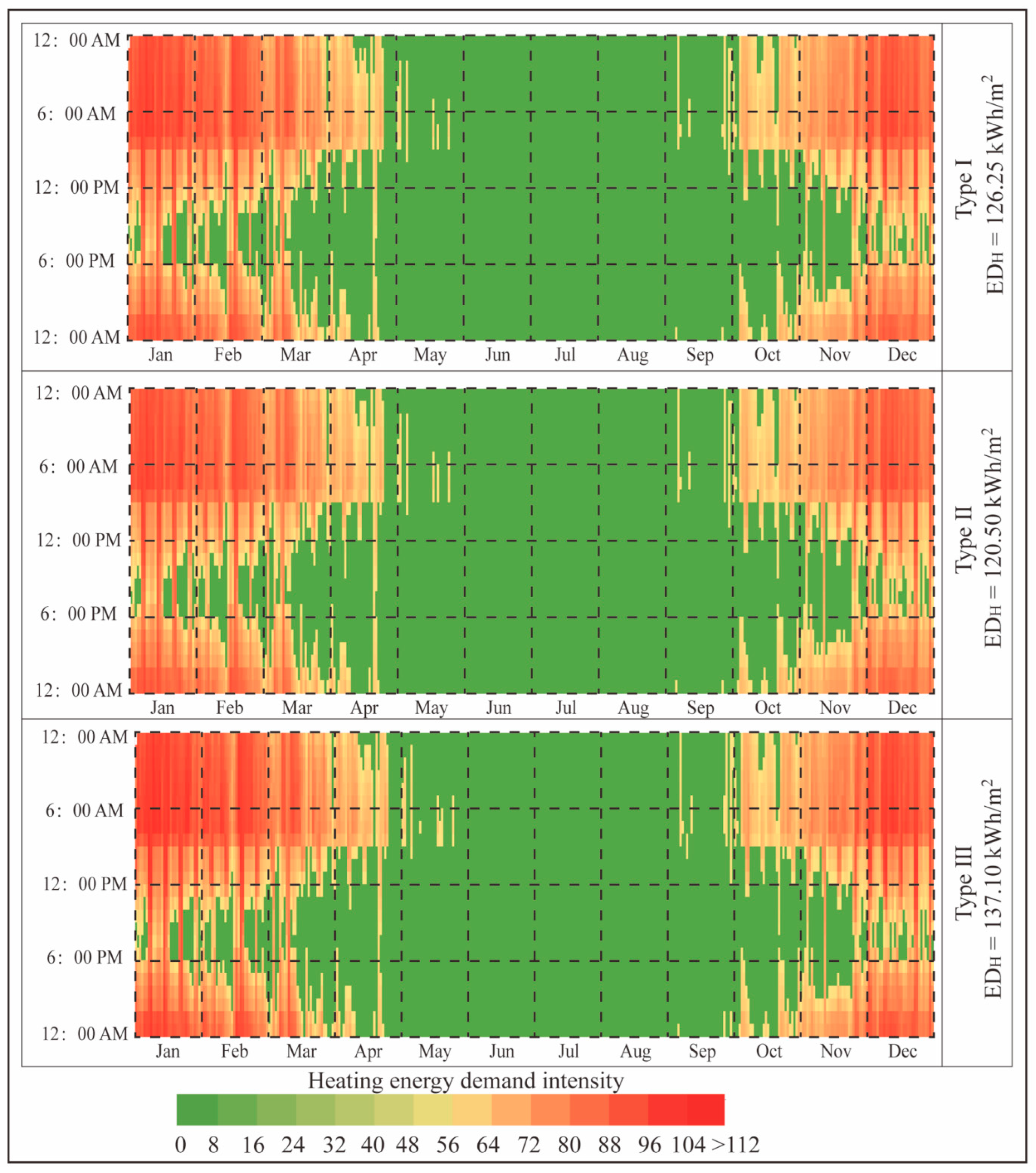
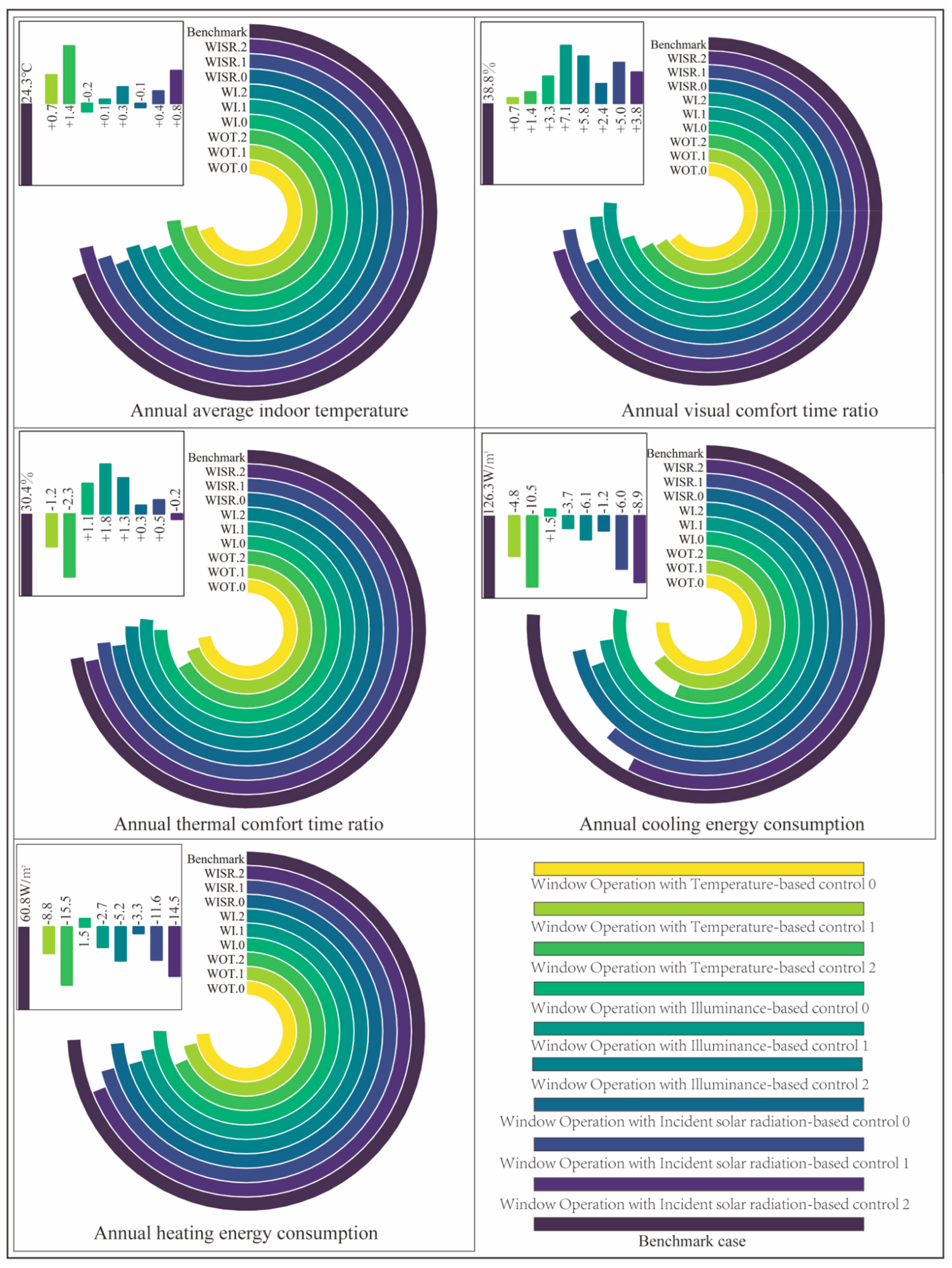
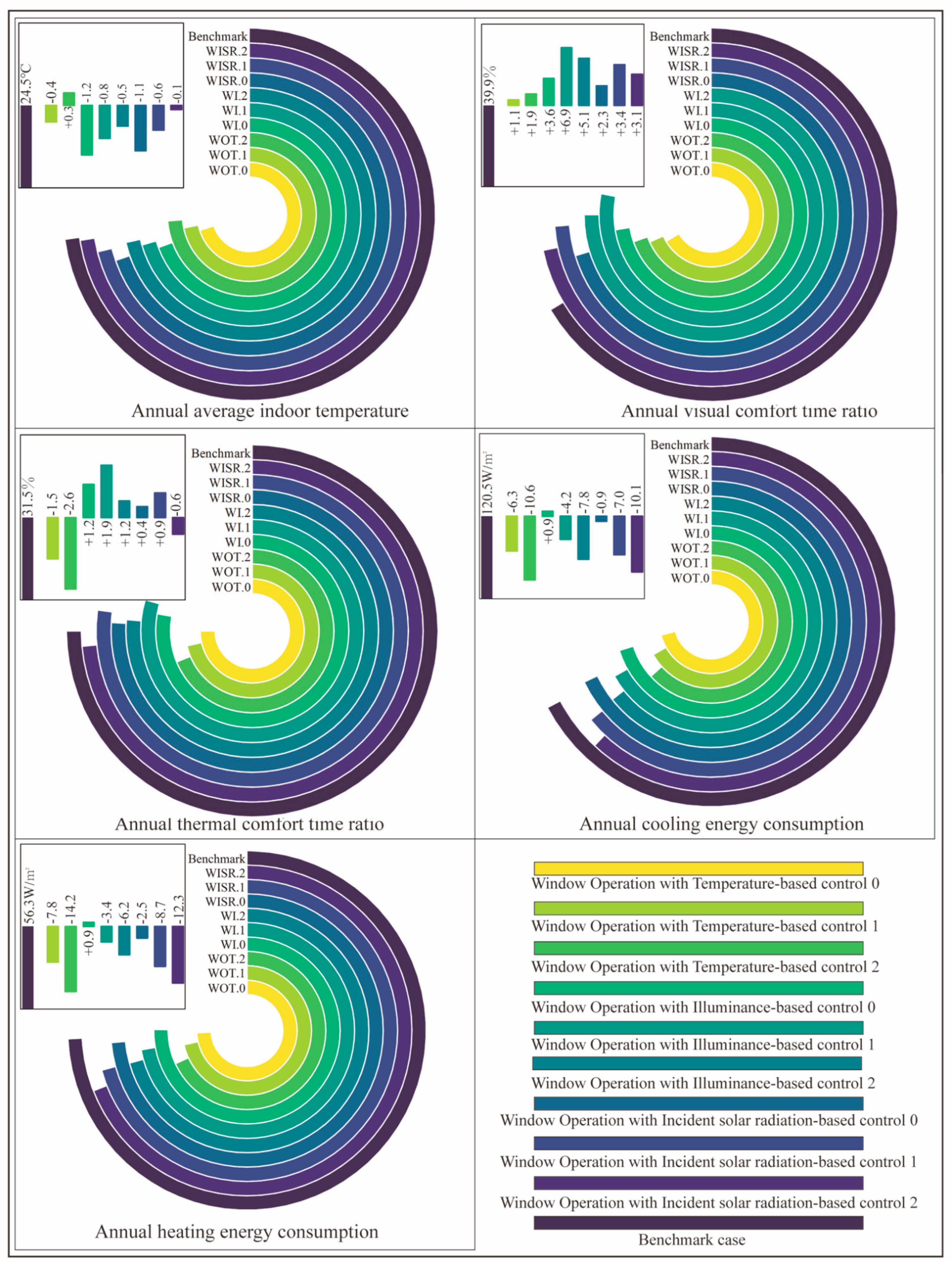
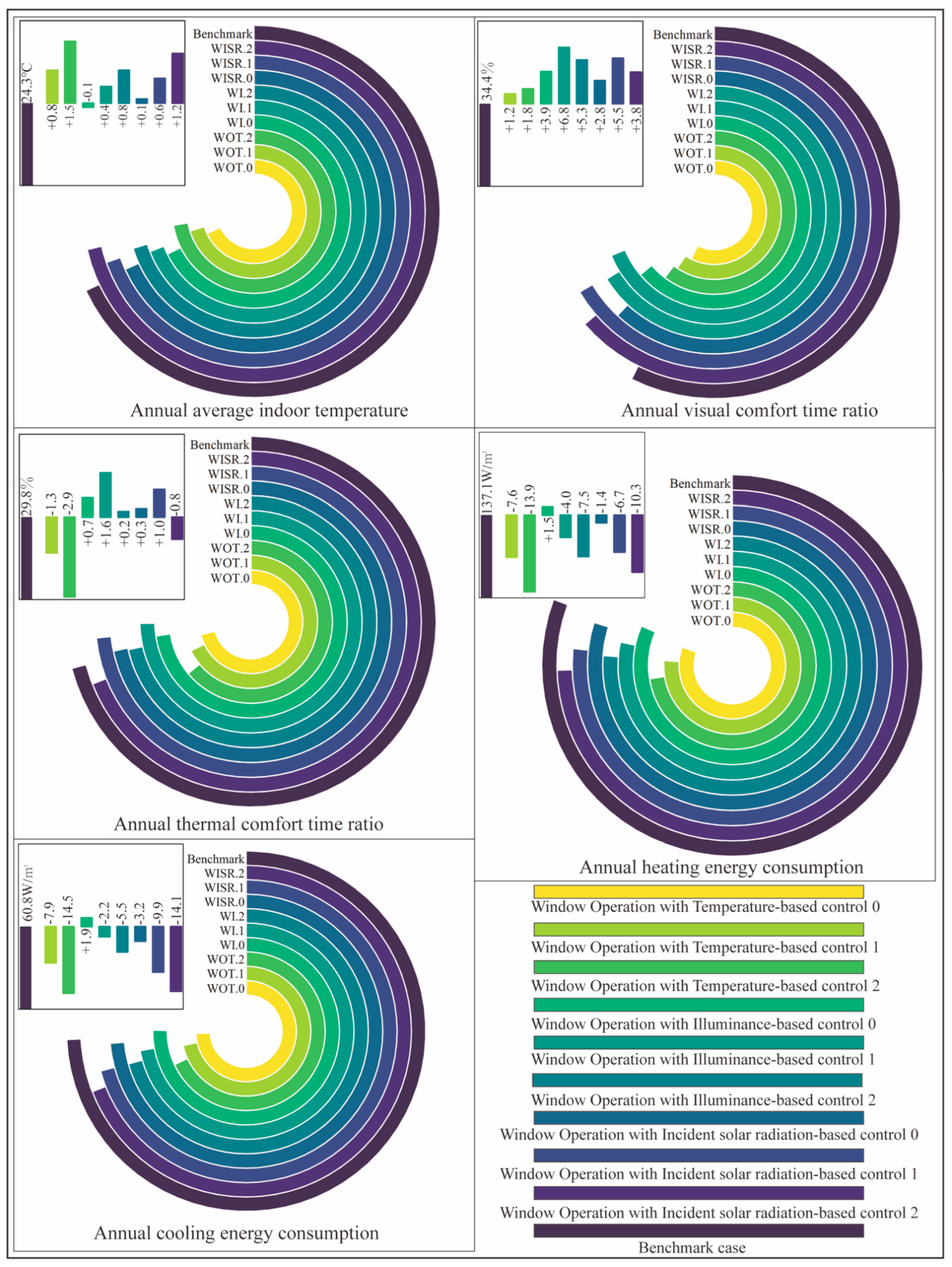
| Indicator | Method/Standard | Unit |
|---|---|---|
| Thermal comfort | ASHRAE Standard 55-2010. adaptive model (80% range) [43]; Tcom based on 7–30 day running mean outdoor temperature | % |
| Visual comfort | Useful daylight illuminance (UDI300–1000) [44]; 1 m grid, 1.2 m sensors | % |
| Indoor temperature | Hourly simulation average | °C |
| Cooling energy use | Annual cooling demand; energy use intensity | kWh/m2 |
| Heating energy use | Annual heating demand; energy use intensity | kWh/m2 |
| Control Strategy | State | |
|---|---|---|
| Temperature | wot,0 | S1 (<20 °C); S2 (21–25 °C); S3 (26–30 °C); S4 (>30 °C); |
| wot,1 | S1 (<20 °C); S2 (21–30 °C); S3 (31–40 °C); S4 (>40 °C); | |
| wot,2 | S1 (<20 °C); S2 (21–35 °C); S3 (36–50 °C); S4 (>50 °C); | |
| Illuminance | wi,0 | S1 (0–100 Lux); S2 (101–300 Lux); S3 (301–500 Lux); S4 (>500 Lux); |
| wi,1 | S1 (0–300 Lux); S2 (301–400 Lux); S3 (401–500 Lux); S4 (>500 Lux); | |
| wi,2 | S1 (0–100 Lux); S2 (101–200 Lux); S3 (201–300 Lux); S4 (>300 Lux); | |
| Incident solar radiation | wisr,0 | S1 (0–60 W/m2); S2 (61–80W/m2); S3 (81–100 W/m2); S4 (>100 W/m2); |
| wisr,1 | S1 (0–60 W/m2); S2 (61–180 W/m2); S3 (181–300 W/m2); S4 (>300 W/m2); | |
| wisr,2 | S1 (0–100 W/m2); S1 (101–20 W/m2); S1 (201–300 W/m2); S1 (>300 W/m2); |
| Electrochromic Window States | U-Value [W/m2·K] | SHGC [–] | VT [%] |
|---|---|---|---|
| State 1 (S1, bleached) | 1.63 | 0.47 | 62.1 |
| State 2 (S2) | 1.63 | 0.17 | 21.2 |
| State 3 (S3) | 1.63 | 0.11 | 5.9 |
| State 4 (S4, fully tinted) | 1.63 | 0.09 | 1.0 |
| Parameters | Values |
|---|---|
| Occupant density [person/m2] | 0.65 |
| Fresh air per person [m3/h] | 30 |
| Average illuminance setting of working face [lux] | 500 |
| Cooling setpoint [°C] | 26 |
| Heating setpoint [°C] | 18 |
| Internal heat gain | Lighting: 8 W/m2; equipment: 5 W/m2 |
| Thermal conductivity of external wall [W/m·K] | 0.9 |
| Thickness of external wall [m] | 0.24 |
| Thermal performance of internal wall [–] | Adiabatic |
Disclaimer/Publisher’s Note: The statements, opinions and data contained in all publications are solely those of the individual author(s) and contributor(s) and not of MDPI and/or the editor(s). MDPI and/or the editor(s) disclaim responsibility for any injury to people or property resulting from any ideas, methods, instructions or products referred to in the content. |
© 2025 by the authors. Licensee MDPI, Basel, Switzerland. This article is an open access article distributed under the terms and conditions of the Creative Commons Attribution (CC BY) license (https://creativecommons.org/licenses/by/4.0/).
Share and Cite
Gao, F.; Yao, X.; Qiao, Z.; Xue, Y. Performance Evaluation of Electrochromic Windows in Cold-Region University Classrooms: A Multi-Scale Simulation Study. Buildings 2025, 15, 3712. https://doi.org/10.3390/buildings15203712
Gao F, Yao X, Qiao Z, Xue Y. Performance Evaluation of Electrochromic Windows in Cold-Region University Classrooms: A Multi-Scale Simulation Study. Buildings. 2025; 15(20):3712. https://doi.org/10.3390/buildings15203712
Chicago/Turabian StyleGao, Fan, Xingbo Yao, Zhi Qiao, and Yanmin Xue. 2025. "Performance Evaluation of Electrochromic Windows in Cold-Region University Classrooms: A Multi-Scale Simulation Study" Buildings 15, no. 20: 3712. https://doi.org/10.3390/buildings15203712
APA StyleGao, F., Yao, X., Qiao, Z., & Xue, Y. (2025). Performance Evaluation of Electrochromic Windows in Cold-Region University Classrooms: A Multi-Scale Simulation Study. Buildings, 15(20), 3712. https://doi.org/10.3390/buildings15203712





